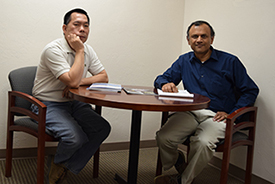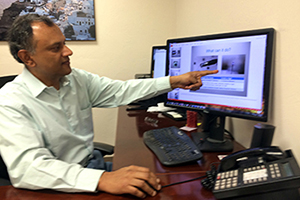 If you tuned in to NPR on Arizona Public Media (AZPM) KUAZ 89.1 FM this morning, April 14, you may have heard Bhaskar Banerjee, MD, a professor of medicine in the Division of Gastroenterology, speaking about his efforts to improve endoscopy technology to make colonoscopies more effective and safer at catching and removing pre-cancerous polyps.
If you tuned in to NPR on Arizona Public Media (AZPM) KUAZ 89.1 FM this morning, April 14, you may have heard Bhaskar Banerjee, MD, a professor of medicine in the Division of Gastroenterology, speaking about his efforts to improve endoscopy technology to make colonoscopies more effective and safer at catching and removing pre-cancerous polyps.
You can hear and read about it here: “UA Team Working To Improve Lifesaving Colonoscopy” (links to audio & article).
AZPM Science Desk reporter Sara Hammond notes U.S. gastroenterologists perform about 14 million colonoscopies and miss about 25 percent of these polyps that may be hidden in folds of the twisting, winding colon.
 To that end, Dr. Banerjee and UA College of Optical Sciences Professor Ron Liang, PhD, have developed a dual-view endoscope that dramatically improves GI doctors' ability to see and thus, remove, these dangerous polyps with just one procedure—rather than running the risk of a mishap with multiple colonoscopies.
To that end, Dr. Banerjee and UA College of Optical Sciences Professor Ron Liang, PhD, have developed a dual-view endoscope that dramatically improves GI doctors' ability to see and thus, remove, these dangerous polyps with just one procedure—rather than running the risk of a mishap with multiple colonoscopies.
A recent MedPage Today article noted that “Colonoscopy Complications Occur at Surprisingly High Rate” —based on a Yale University study that appeared in the journal Gastroenterology. This would reduce that risk and reduce the need for multiple procedures, at a time when colon and rectal cancers arguably may be rising—according to an American Cancer Society study that was later disputed.
The challenge, Dr. Banerjee notes, is not only to be able to see forwards, but backwards with a dual view to see the behind folds of the colon. That’s exactly what he and Dr. Liang came up with, a dual-view endoscope.
“Basically, a lot of lesions in the colon are missed because they hide behind folds,” Dr. Banerjee said. “It can result in unexpected interval cancers and likely brings into question clinical studies that depend on colon polyp detection. We have a device and working prototype that sees forwards and backwards in 360 degrees — which will allow for a ‘complete’ colonoscopy” that catches virtually all polyps.
 He’s looking forward to clinical studies of the device, further commercialization of alternative uses and pressing forward on other ideas to improve detection and treatment of gastrointestinal diseases and illnesses.
He’s looking forward to clinical studies of the device, further commercialization of alternative uses and pressing forward on other ideas to improve detection and treatment of gastrointestinal diseases and illnesses.
Those include: a) label-free multi-photon imaging of abnormal cells in Barrett’s esophagus (frequent heartburn, chest pain often diagnosed as GERD, or reflux disease) to better prevent esophageal cancer; and b) imaging of targeted lipid microbubbles using advanced microscopy for early detection of cancer and inflammatory disorders.
To learn more about Dr. Banerjee’s research, click here.
ALSO SEE:
"Tech Launch AZ Honors Inventors, Startups, Impact-Makers at I-Squared Awards & Expo" | Posted April 24. 2017

